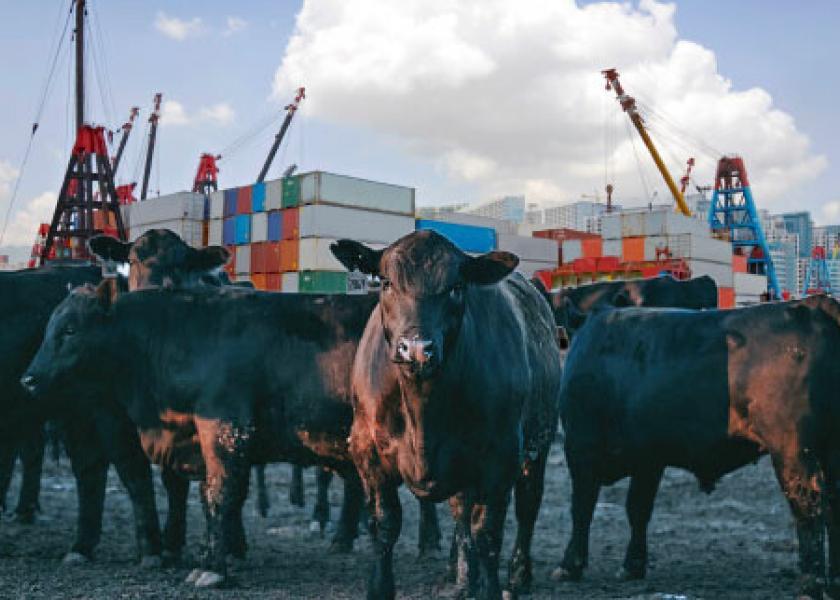Ending Beef Exports/Imports Would Cost Cattlemen $Billions

Entirely ceasing U.S. international beef trade would be an economic catastrophe for America’s beef industry, and retail beef would be even more expensive for American consumers. That’s the conclusion of a new economic report co-authored by livestock economists Glynn Tonsor, Kansas State University, and Derrell Peel, Oklahoma State University.
Even a 10% reduction in U.S. beef exports and imports would cause a significant disruption to prices and quantities of both feeder cattle and fed cattle. Summarizing their analysis in an interview with Drovers, Tonsor and Peel said the cumulative loss from a 10% reduction in exports and imports over 10 years would create an economic loss of $12.9 billion to feeder cattle sellers and $6.8 billion to fed cattle sellers.
The report, “Assessing Economic Impact That Would Follow Loss of U.S. Beef Exports & Imports,” outlines why the U.S. trades beef internationally, summarizes historical beef trade data, quantifies national fed and feeder cattle market impacts that could follow loss of beef trade, and allocates national impacts to state-level impacts. The report was prepared for the Kansas Beef Council, the Oklahoma Beef Council, and the Texas Beef Council.
“It’s hard to over-state the complex and ever-growing role of beef export and imports,” the authors said. “Beef export and imports combine to provide opportunities to increase value to the U.S. industry by exporting products that have more value in foreign markets and importing products that can be sourced more economically in international markets.”
As a point of emphasis, “there’s value in both imports and exports for American cattlemen,” Peel said. “We’re seeking out value and benefit both ways.”
The analysis was initiated by a “long-term interest in understanding the trade more,” Tonsor said. “Industry stakeholders want to understand it better and the pandemic magnified some of that interest.”
Specifically, when COVID disrupted the beef industry in the spring of 2020 and beef processing slowed to a trickle and retail demand skyrocketed, many industry stakeholders wondered why the U.S. continued to import and export beef internationally.
Peel said understanding the ramifications of beef trade is an ongoing interest for cattlemen which led to the project to assess the impact of trade on the U.S. beef industry.
The review found the mix of countries the U.S. exports beef to has developed resulting in a more diverse, less concentrated export portfolio. Conversely, sources of U.S. beef imports have comparatively fluctuated less over time.
“Implied trade prices clearly show the U.S. receives a higher dollar per pound value for exports than it pays for imports reflecting core differences in product type and the role of each transaction in adding economic value,” the authors wrote. “From 2016 through 2020, the U.S. experienced average annual unprepared beef exports of 2.05 billion pounds, export value of $6.4 billion, and implied export price of $3.13 per pound. Conversely, 2016-2020 average annual unprepared beef imports were 2.30 billion pounds, import value was $5.8 billion, and implied import price was $2.52 per pound. These statistics clearly indicate participation in the global market provides a net economic gain.”
Extrapolating the 10% loss of beef trade in the author’s example cited earlier to a more extreme, full 100% loss would suggest a catastrophic impact, “broadly approximated at $129 billion for feeder cattle sellers and $68 billion for fed cattle sellers reflecting a much smaller overall industry.”
Impact on Consumers
Cattlemen are not the only ones to benefit from international beef trade. Without such trade, retail and food service beef products are more expensive for American consumers.
The ground beef market provides an example.
“We would not be able to supply the ground beef market at the size it is today” without imports, Peel said. “Or, if we did, it would be because we were grinding a lot of more expensive lean products out of the U.S. domestic supply to make it work. That would inevitably have a big impact in terms of raising the price of ground beef and taking that value away from other markets where it’s currently being used.”
Imported trim makes up just over half of beef imports and is used primarily for ground beef but also for a variety of other processed beef products including sausage products, the authors wrote. Processing beef is also used for numerous prepared products including frozen meals, entrees and other processed products. While some processed products appear at retail, most imported trim is used for food service ground beef.
Reliance on imported beef has remained relatively steady, but U.S. beef exports have grown increasingly important. Peel and Tonsor note that the U.S. Meat Export Federation provides estimates of the per head slaughtered value represented by beef and variety meat exports. That value was about $300 per head in 2014 and had grown to more than $400 per head by November 2021.
“Since 2015 the percent of fed cattle value derived from exports has continued to grow relative to volume,” Peel and Tonsor wrote. “For instance, current estimates for 2021 indicate 22% of fed cattle value is attributable to exports vs. only 15% of production (when considering both beef and variety meat). This is a classic example of demand growth and likely reflects increasing success in getting U.S. products in the hands of those most valuing them.”
Peel and Tonsor said the economic importance of beef exports and imports is substantial and growing with time. “In the absence of beef trade, the entire industry would shrink significantly.”







